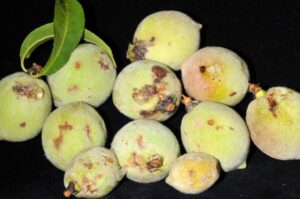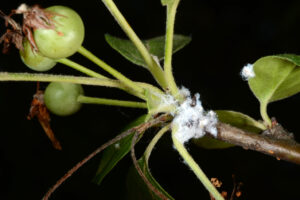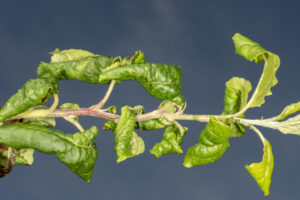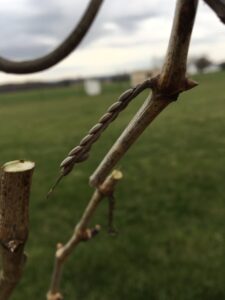We all know that growing and protecting delicious fruit is a challenge! Whether you’re producing tree fruits, stone fruits, berries, or drupes, all kinds of insect pests are out to exploit the fruits of your labor. Despite our best efforts, sometimes a few insect pests slip under the radar and all you can do is learn what to look for and how to improve your protective efforts next season. A key part of this is being confident that you know what the signs and symptoms of insects and their damage look like!
When you hear educators and specialists talk about signs of insects, they are referring to the insect itself, or the physical evidence it left behind on the plant or fruit. Signs of insect activity include the presence of eggs, or insect waste, like the solid waste left behind by feeding caterpillars (called frass), or the liquid waste left behind by aphids (called honeydew). Another common sign of insect activity is the presence of shed exoskeletons or “caste off skins,” which are left behind when insects molt from one immature life stage to the next. Insects must excrete waste and molt to grow and survive, so there’s no way for them to avoid leaving this evidence behind – and we can captilize on that! Look for insect signs on both the inside and outside of plants and the fruit. Sometimes you may have to cut open fruit, twigs, or branches to spot signs of insect pests, because they may not be obvious from the outside. Insect signs can help you diagnose the kind of insect that is causing problems and from there you can narrow down management options that will be effective.
When educators and specialists talk about symptoms of insects, they are referring to visible indicators from the plant that something is wrong. I often think of this as the plant “calling out for help.” Symptoms of insect activity include yellowing or curled leaves, wilting, oozing wounds (on branches or fruit), and leaves or fruit with chewing or sucking damage. Premature fruit drop is another example of a symptom that you should investigate for insect activity if it is occurring unexpectedly. It is critical to know the symptoms of insect damage, because you may never actually spot the insect that was responsible. In fact, in nearly all perennial fruit systems, there is an insect pest whose damage appears long after the insect is already gone. Symptoms on the plant or fruit can help you diagnose the kind of insect, sometimes even a specific insect, that is causing problems so you can respond accordingly. With all that being said, I want to mention here that symptoms of nutritional deficiency, plant stress, or even plant pathogens can be mistaken for symptoms of insect damage, so keep that in mind and investigate thoroughly before deciding to take action. If you’re ever unsure, we’re happy to help you do the detective work at the Purdue Plant & Pest Diagnostic Lab!
I have included some images below of insect signs and symptoms! Are these signs or symptoms? Can you guess who is responsible? Stay tuned for the answers in the next issue of Facts for Fancy Fruit! And just a reminder, if your orchard is still in bloom, please remember to protect our pollinators by not spraying during this time. 😊



